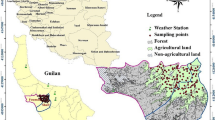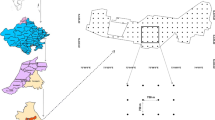Abstract
The loss of cultivated land has increasingly become an issue of regional and national concern in China. Definition of management zones is an important measure to protect limited cultivated land resource. In this study, combined spatial data were applied to define management zones in Fuyang city, China. The yield of cultivated land was first calculated and evaluated and the spatial distribution pattern mapped; the limiting factors affecting the yield were then explored; and their maps of the spatial variability were presented using geostatistics analysis. Data were jointly analyzed for management zone definition using a combination of principal component analysis with a fuzzy clustering method, two cluster validity functions were used to determine the optimal number of cluster. Finally one-way variance analysis was performed on 3,620 soil sampling points to assess how well the defined management zones reflected the soil properties and productivity level. It was shown that there existed great potential for increasing grain production, and the amount of cultivated land played a key role in maintaining security in grain production. Organic matter, total nitrogen, available phosphorus, elevation, thickness of the plow layer, and probability of irrigation guarantee were the main limiting factors affecting the yield. The optimal number of management zones was three, and there existed significantly statistical differences between the crop yield and field parameters in each defined management zone. Management zone I presented the highest potential crop yield, fertility level, and best agricultural production condition, whereas management zone III lowest. The study showed that the procedures used may be effective in automatically defining management zones; by the development of different management zones, different strategies of cultivated land management and practice in each zone could be determined, which is of great importance to enhance cultivated land conservation, stabilize agricultural production, promote sustainable use of cultivated land and guarantee food security.








Similar content being viewed by others
References
Aggelopooulou K, Castrignanò A, Gemtos T, Benedetto DD (2013) Delineation of management zones in an apple orchard in Greece using a multivariate approach. Comput Electron Agric 90:119–130
Ahn CW, Baumgardner MF, Biehl LL (1999) Delineation of soil variability using geostatistics and fuzzy clustering analyses of hyperspectral data. Soil Sci Soc Am J 63:142–150
Bao SD (2000) Soil and agricultural chemistry analysis [in Chinese]. China Agricultural Press, Beijing
Bezdek JC (1981) Pattern recognition with fuzzy objective function algorithms. Plenum, New York
Boydell B, McBratney AB (1999) Identifying potential within-field management zones from cotton yield estimates. In: Stafford JV (ed) Proceedings of the second European conference on precision agriculture. Odense Congress Center, Odense, Denmark, pp 331–341
Bremner JM, Mulvaney CS (1984) Total nitrogen. In: Page AL (ed) Methods of soil analysis. Agronomy no. 9, part 2: chemical and microbiological properties, 2nd edn. American Society of Argonomy, Madison, pp 595–624
Brown G (1995) Arable land loss in rural China: policy and implementation in Jiangsu Province. Asian Surv 35(10):922–940
Burrough PA, Macmillan RA, Deursen WV (1992) Fuzzy classification methods for determining land suitability from soil profile observations and topography. J Soil Sci 43:193–210
Castrignano A, Guastaferro F, De Benedetto D, Sollitto D, Troccoli A, Cafarelli B (2010) A comparison of different algorithms for the delineation of management zones. Precis Agric 11(6):600–620
Chien YJ, Lee DY, Guo HY, Houng KH (1997) Geostatistical analysis of soil properties of mid-west Taiwan soils. Soil Sci 162(4):291–298
Costantini M, Farina A, Zirilli F (1997) The fusion of different resolution SAR images. Proc IEEE 85(1):139–146
Daniels T, Bowers D (1997) Holding our ground: protecting America’s farms and farmland. Island Press, Washington, DC, p 334
Davatgar N, Neishabouri MR, Sepaskhah AR (2012) Delineation of site specific nutrient management zones for a paddy cultivated area based on soil fertility using fuzzy clustering. Geoderma 173–174:111–118
Deng XZ, Huang JK, Rozelle S, Uchida E (2006) Cultivated land conversion and potential agricultural productivity in China. Land Use Policy 23(4):372–384
Eghball B, Hergert GW, Lesoing GW, Ferguson RB (1999) Fractal analysis of spatial and temporal variability. Geoderma 88:349–362
Fleming KL, Heermann DF, Westfall DG (2004) Evaluating soil color with farmer input and apparent soil electrical conductivity for management zone delineation. Agron J 96:1581–1587
Flowers M, Weisz R, White JG (2005) Yield-based management zones and grid sampling strategies: describing soil test and nutrient availability. Agron J 97:968–982
Fraisse CW, Sudduth KA, Kitchen NR (2001) Delineation of site-specific management zones by unsupervised classification of topographic attributes and soil electrical conductivity. Trans ASAE 44(1):155–166
Fridgen JJ, Kitchen NR, Sudduth KA, Drummond ST, Wiebold WJ, Fraisse CW (2004) Management zone analyst (MZA): software for subfield management zone delineation. Agron J 96(1):100–108
Gamma Design, Inc. (2000) GS+ user’s manual for Windows. Gamma Design Software, Plainwell
Gardner B (1977) The economics of agricultural land preservation. Am J Agric Econ 59(5):1027–1036
Gessler PE, Chadwick OA, Chamran F, Althouse L, Holmes K (2000) Modeling soil–landscape and ecosystem properties using terrain attributes. Soil Sci Soc Am J 64(6):2046–2056
Ian J (2005) Principal component analysis. Encyclopedia of statistics in behavioral science. Wiley, New York
Jaynes DB, Kaspar TC, Colvin TS, James DE (2003) Cluster analysis of spatiotemporal corn yield patterns in an Iowa field. Agron J 95(3):574–586
Jaynes DB, Kaspar TC, Colvin TS (2011) Economically optimal nitrogen rates of corn: management zones delineated from soil and terrain attributes. Agron J 103(4):1026–1035
Jiang YG (2012) Cultivated land quality and fertilizer management in Chinese Fuyang city [in Chinese]. Chinese Agricultural Science and Technology Press, Beijing
Jiang HL, Liu GS, Wang R, Liu SD, Han FG, Yang YF et al (2011) Delineating site-specific quality-based management zones for a tobacco field. Soil Sci 176(4):206–212
Johnson CK, Mortensen DA, Weinhold BJ, Shanahan JF, Doram JW (2003) Site-specific management zones based on soil electrical conductivity in a semiarid cropping system. Agron J 95:303–315
Journel AG, Huijbregts CJ (1987) Mining geostatistics. Academic Press, London
Kitchen NR, Snyder CJ, Frazen DW, Wiebold WJ (2002) Educational needs of precision agriculture. Precis Agric 3:341–351
Kitchen NR, Sudduth KA, Myers DB, Drummond ST, Hong SY (2005) Delineation productivity zones on clay pan soil fields using apparent soil electrical conductivity. Comput Electron Agric 46:285–308
Lark RM (1998) Forming spatially coherent regions by classification of multivariate data: an example from the analysis of maps of crop yield. Int J Geogr Inf Sci 12:83–98
Lark RM, Stafford JV (1997) Classification as a first step in the interpretation of temporal and spatial variation of crop yield. Ann Appl Biol 130:111–121
Li Y, Shi Z, Li F, Li HY (2007) Delineation of site-specific management zones using fuzzy clustering analysis in a coastal saline land. Comput Electron Agric 56(2):174–186
Li W, Feng TT, Hao JM (2009) The evolving concepts of land administration in China: cultivated land protection perspective. Land Use Policy 26(2):262–272
Liu XP, Li X, Tan ZZ, Chen YM (2011) Zoning farmland protection under spatial constraints by integrating remote sensing, GIS and artificial immune systems. Int J Geogr Inf Sci 25(11):1829–1848
Long DS, Carlson GR, DeGloria SD (1994) Quality of field management maps. In: Robert PC, Rust RH, Larson WE (eds) Proceedings of the 2nd international conference on site-specific management for agricultural systems. ASA, CSSA, SSSA, Madison, pp 251–271
Mann KK, Schumann AW, Obreza TA (2011) Delineating productivity zones in a citrus grove using citrus production tree growth and temporally stable soil data. Precis Agric 12(4):457–472
McBratney AB, DeGruijter JJ (1992) A continuum approach to soil classification by modified fuzzy k-means with extra grades. J Soil Sci 43:159–175
Milne AE, Webster R, Ginsburg D, Kindred D (2012) Spatial multivariate classification of an arable field into compact management zones based on past crop yields. Comput Electron Agric 80:17–30
Moore ID, Gessler PE, Nielsen GA, Peterson GA (1993) Soil attribute prediction using terrain analysis. Soil Sci Soc Am J 57(2):443–452
Moral FJ, Terrón JM, Marques JR, Silva da (2010) Delineation of management zones using mobile measurements of soil apparent electrical conductivity and multivariate geostatistical techniques. Soil Tillage Res 106:335–343
Nelson DW, Sommers LE (1982) Total carbon, organic carbon and organic matter. In: Page AL, Miller RH (eds) Methods of soil analysis. Part 2. Chemical and microbiological properties. American Society of Agronomy, Madison
Odeh IOA, Mcbratney AB, Chittleborough DJ (1992) Soil pattern-recognition with fuzzy-C-means application to classification and soil–landform interrelationships. Soil Sci Soc Am J 56(2):505–516
Olsen SR, Cole CV, Watanabe FS, Dean LA (1954) Estimation of available phosphorus in soils by extraction with sodium bicarbonate. United States Drug Administration Circular 939. USDA, Washington, DC
Ortega RA, Santibáñez OA (2007) Determination of management zones in corn (Zea mays L.) based on soil fertility. Comput Electron Agric 58:49–59
Ping JL, Dobermann A (2003) Creating spatially contiguous yield classes for site-specific management. Agron J 95:1121–1131
Richards LA (1954) Diagnosis and improvement of saline and alkaline soil. United States Drug Administration Handbook No. 60. US Government Printing Office, Washington, DC, p 160
Schepers AR, Shanaham JF, Liebig MA, Schepers JS, Johnson SH, Luchiari JA (2004) Appropriateness of management zones for characterizing spatial variability of soil properties and irrigated corn yields across years. Agron J 96:195–203
Shao JA, Ge XF, Wei CF, Xie DT (2007) Classification and gradation of cultivated land quality in Bishan county of Chongqing, China. Chin Geogr Sci 17(1):82–91
Sharma S (1996) Applied multivariate techniques. Wiley, New York
She LM, Xie BG (2000) Some considerations about the dynamic balance of the total cultivated land quantity in China [in Chinese]. Res Agric Modern 21(2):87–90
Stafford JV, Lark RM, Bolam HC (1998) Using yield maps to regionalize fields into potential management units. In: Robert PC (ed) Proceedings of the fourth international conference on precision agriculture. ASA, CSSA, SSSA, Madison, WI, pp 225–237
Taylor JC, Wood GA, Earl R, Godwin RJ (2003) Soil factors and their influence on within-field crop variability, part II: spatial analysis and determination of management zones. Biosyst Eng 84:441–453
Wang XZ, Liu GS, Hu HC, Wang ZH, Liu QH, Liu XF et al (2009) Determination of management zones for a tobacco field based on soil fertility. Comput Electron Agric 65(2):168–175
Warrick AW (1998) Spatial variability. In: Hillel D (ed) Environmental soil physics. Academic Press, San Diego
Whelan BM, McBratney AB (2000) The null hypothesis of precision agriculture management. Precis Agric 2:265–279
Wu HX, Jiang YG, Zhang JT, Shi Z (2011) Quality evaluation of farmland and fertilization management in Fuyang county [in Chinese]. Trans CSAE 27(12):307–312
Yan HM, Liu JY, Huang HQ, Tao B, Cao MK (2009) Assessing the consequence of land use change on agricultural productivity in China. Glob Planet Change 67:13–19
Yang H, Li XB (2000) Cultivated land and food supply in China. Land Use Policy 17(2):73–88
Zhang F (1998) Several questions in maintaining a dynamic balance of total cultivated land. China Land 11:28–30
Acknowledgments
We thank the following organizations for their financial support for this work: the National High Technology Research and Development Program of China (863 Program, Grant No. 2013AA102301), the National Natural Science Foundation of China (Grants No. 30700098 and 40701007), Zhejiang Provincial Natural Science Foundation of China (Grants No. Y3090198 and Y507207), and the Key Project of Zhejiang Provincial Education Department (Grant No. Z201121260). We are grateful for the constructive comments of the anonymous reviewers provided on an early version of the manuscript.
Author information
Authors and Affiliations
Corresponding author
Rights and permissions
About this article
Cite this article
Li, Y., Shi, Z., Wu, HX. et al. Definition of Management Zones for Enhancing Cultivated Land Conservation Using Combined Spatial Data. Environmental Management 52, 792–806 (2013). https://doi.org/10.1007/s00267-013-0124-7
Received:
Accepted:
Published:
Issue Date:
DOI: https://doi.org/10.1007/s00267-013-0124-7




